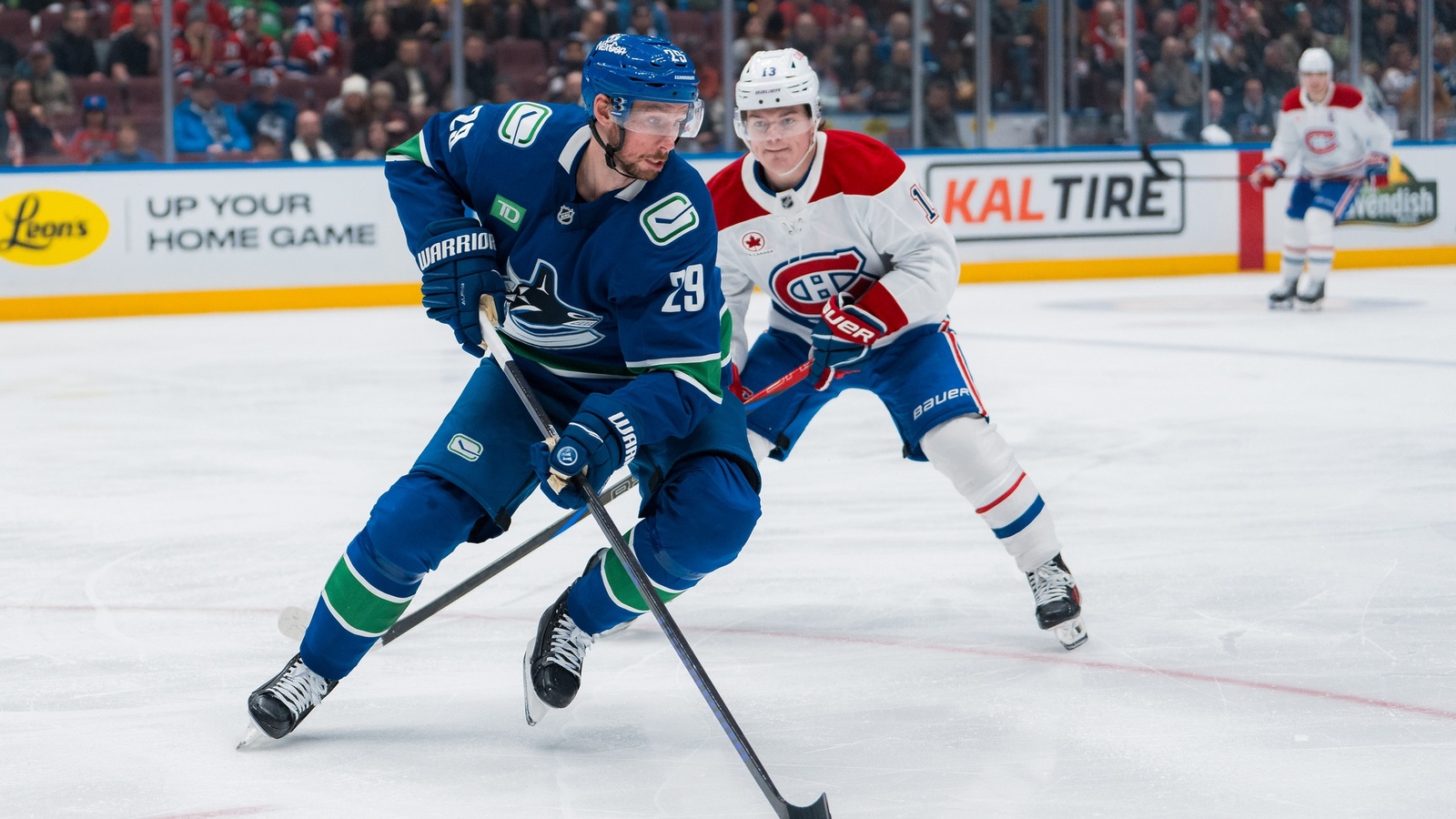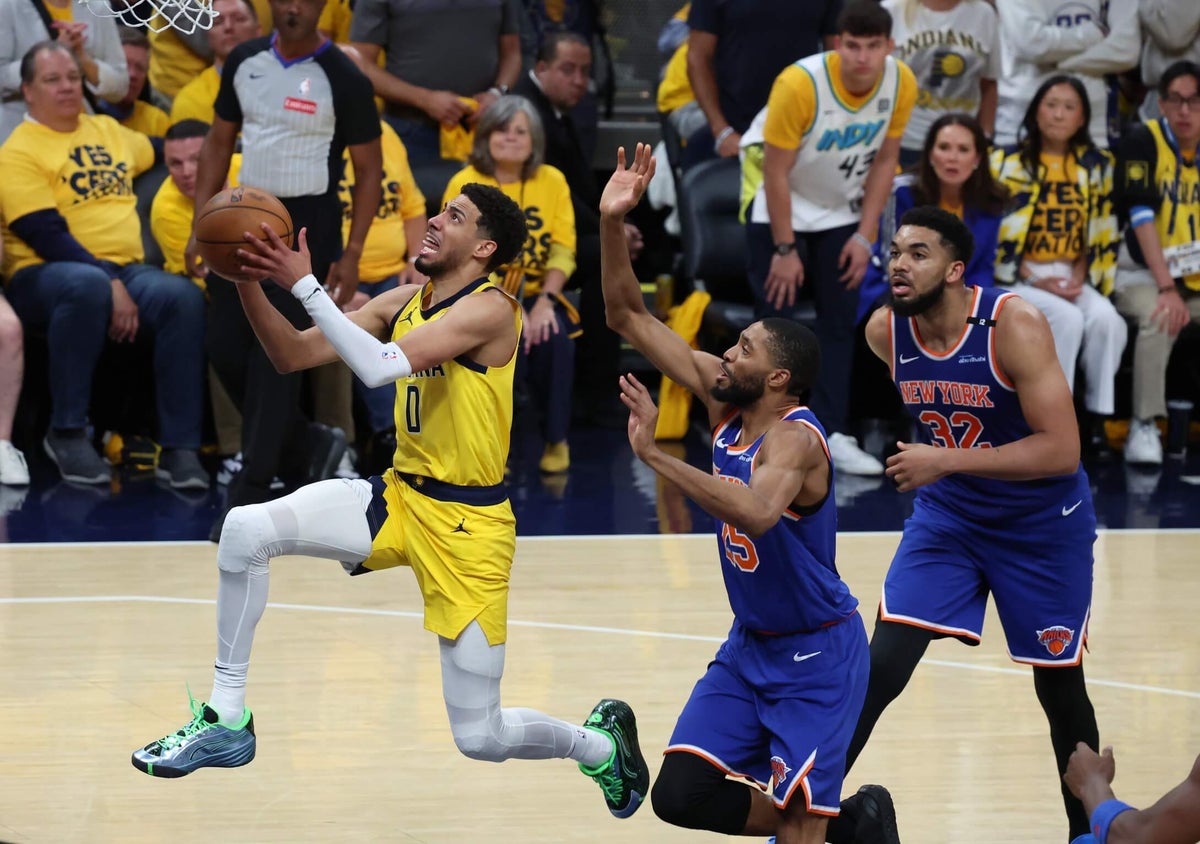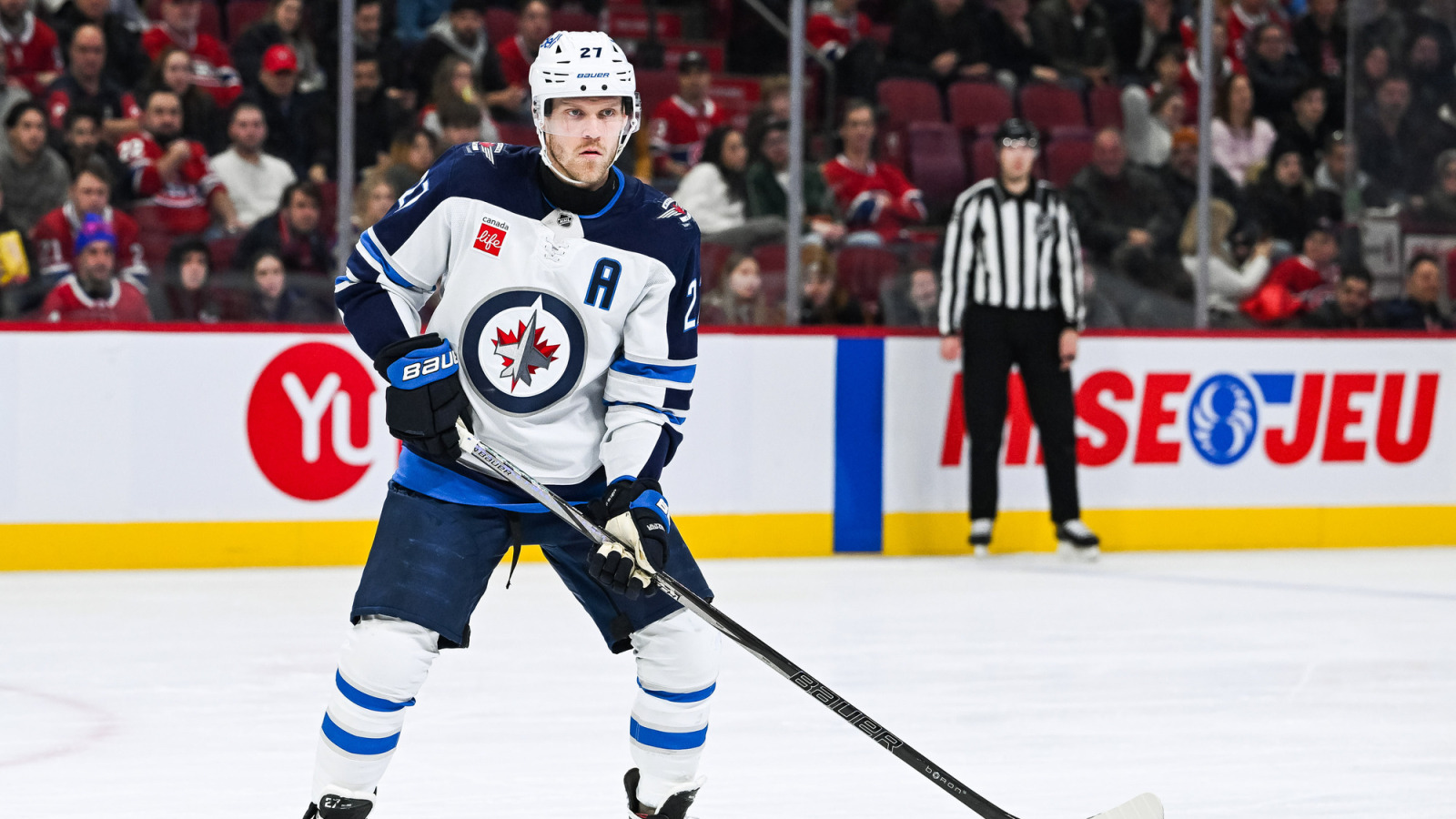
Marcus Pettersson spent a large portion of the 2024/25 as the top rental D available on the NHL market.
Until he wasn’t either of those things.
The dramatic events of January 31, 2025, will continue to impact the Vancouver Canucks franchise for years to come. Moments ahead of that night’s game against the Dallas Stars, it was announced that JT Miller would not be playing…because he’d been traded.
Before puck-drop, the details of that transaction had trickled out. It was Miller, Erik Brännström, and prospect Jackson Dorrington to the New York Rangers in exchange for Filip Chytil, Victor Mancini, and a conditional first round pick.
But fans never got to sit with that trade as a singular entity for very long. Shortly after the game concluded, another trade was announced. This time, it was that same conditional first round pick heading to Pittsburgh, along with Danton Heinen, Vincent Desharnais, and prospect Melvin Fernstrom. The return was a two-parter, consisting of then-pending UFAs Drew O’Connor and the Canucks’ third and latest Pettersson.
But the Canucks and their fans didn’t have much time to get used to Rental Pettersson, either. Just five days after the trade, on February 5, 2025, Pettersson extended with the Canucks for six years at an average annual value of $5.5 million.
A player acquired to be a missing piece on the blueline had quickly become a permanent fixture. Thankfully, Pettersson would spend much of the rest of the 2024/25 campaign proving himself worthy of the acquisition cost, the extension price (and then some), and the responsibility being laid on his shoulders to transform the Vancouver D-corps into something more than just ‘adequate.’
Marcus Pettersson’s Season Narrative
Pettersson spent the first half of the season on a Pittsburgh Penguins team going nowhere fast, and although this is a Canucks Year in Review, we’ll take some time to briefly summarize that stint.
This was Pettersson’s seventh season in Pittsburgh, and saw him play 47 games with three goals and 18 points. Which, had he continued at that same pace, would have resulted in career-high results. (It’s a pace of 31 points. Pettersson’s career-high of the previous year was 30. He actually finished 2024/25 with 29.)
At the time of the trade, Pettersson was averaging some 22:03 a night, just behind Kris Letang (23:33) and Erik Karlsson (22:51) on the Penguins’ blueline. And given the aging reputations of those two individuals, it should come as no surprise that Pettersson took the toughest matchups and deployments of the bunch. His on-ice goal differential of just -4 was fairly impressive, then, with the quality of the team around him and his role both considered.
That becomes even more apparent when Pettersson’s Pittsburgh analytics are examined. A 52.13% Corsi rating, a 55.27% rate of expected goals, and a whopping 57.14% control of high-danger chances.
Technically-speaking, Pettersson was the Penguins’ 3D. However, there’s definitely an argument to be made that he was both their most important and most effective overall defender at the time of the trade.
Now, it would typically be difficult to say that a defensively-oriented blueliner made an immediate impact. Normally, such players’ contributions are a little subtler, and the change they make to a team can take time to materialize.
But not so with Marcus Pettersson’s arrival in Vancouver.
From the jump, it was apparent that he would be a major steadying presence on the blueline. Virtually overnight, the Canucks’ D corps went from questionable to solid, to the point that some are now calling it “complete.”
https://x.com/nhl_goal_bot/status/1896045125781901437
It wasn’t due to an influx of offence. Pettersson’s scoring pace actually slowed down in Vancouver compared to where it was at in Pittsburgh, if only slightly. It took him eight games to get his first point as a Canuck (an assist on March 1 against Seattle), and he’d only ever notch one goal in Vancouver in the third-last game of the season.
https://x.com/SNstats/status/1911249379358286172
But it should be noted that the first assist did kick off a little bit of a run for both the Canucks and Pettersson himself, who put up 11 points in 23 games to close out March and April.
And it should also be noted that Pettersson’s game revolves around a lot more than just putting up points.
Again, the key word here is ‘steady.’ Prior to his arrival, the Canucks’ blueline looked decidedly unsettled behind Quinn Hughes.
Pettersson was very quickly paired with Tyler Myers, who was in the midst of a bit of a slide-back season after a strong 2023/24. Right away, the two found success together, and Pettersson was able to elevate Myers back to at least the standard of the previous season.
Pettersson would wind up sharing more than half of his Vancouver ice-time with Myers, and the two would enjoy a positive goal-differential (+4) while taking on the toughest oppositional matchups on most nights. This, even as the Canucks around them fell out of playoff contention.
Pettersson’s next-most-frequent partner was Filip Hronek, and the two of them made up Vancouver’s top pairing for the bulk of Hughes’ early-March absence from the lineup.
That time coincided with Pettersson’s aforementioned offensive bloom. But it also coincided with a noticeable uptick in Hronek’s quality of play. Most gave Hronek ample credit for elevating his game to that of a true 1D in Hughes’ absence, stepping up when the Canucks needed him most, with the MVP-captain out and the season on the line. Fewer gave credit to Pettersson for the vital support that made Hronek’s step-up possible.
That’s kind of the line on Pettersson’s time in Vancouver. Pick out something going right for the Canucks, and Pettersson probably had something to do with it, even if the connection wasn’t readily apparent.
The Vancouver penalty kill went on a mid-season heater than resulted in them finishing with the third-best kill rate of 82.6% in the entire NHL. Many Canucks received flowers for this accomplishment, including Myers, Derek Forbort, and now-head coach Adam Foote. But it was Pettersson who wound up leading the Canucks in average nightly shorthanded time with 2:23 a game.
The Canucks also got a lot of attention for their physicality in 2024/25, mostly due to Kiefer Sherwood’s record-breaking performance. Among the blueliners, Pettersson’s hits-per-60 of 2.10 was actually the second-lowest on the blueline, after Hughes.
And yet, Pettersson found a way to make an impression with his physicality all the same, due to his ability to consistently separate forwards from the puck with his hits – and because some of them were of the bone-rattling variety.
https://x.com/CanucksArmy/status/1911256426745675926
Really, there wasn’t anything Pettersson didn’t do well for the Canucks after his acquisition. For a blueline that needed at least a little improvement across the board, Pettersson arrived as a player capable of providing a little bit of everything.
That’s what made his presence on the Vancouver blueline so transformative. Combine his appearance with the breakout performance of the younger Elias Pettersson and the recent signing of Tom Willander, and it’s a totally and effectively remodeled blueline.
Oh, and one more thing. We can’t go too much further without talking about the nigh-unholy excess value of that extension.
Pettersson signed his new contract after the three years of consecutive cap ceiling increases were announced, but before the league and its managers had fully adjusted to the new reality. As such, it has all the makings of a contract that would have been of roughly fair value in the old financial era – but that already looks like a drastic underpay by the new standard.
As of right now, Pettersson’s $5.5 million cap hit is tied as the 57th-highest among NHL defenders for the 2025/26 season. Wait until this explosive summer of signings is complete, however, and he’ll have no doubt slid several spots down the list.
That already puts Pettersson in ‘second-pairing’ territory, salary-wise, when he’s typically played to a top-pairing quality in his recent career. Give it another summer, and he’ll almost certainly be making the equivalent of ‘low-end 4D’ money.
For a contract that will cover him from age 29 to 34, that’s just exceptionally efficient, and it only serves to make Pettersson an even more valuable asset for the Canucks as they attempt to balance their books and build up a stronger roster around him.
The Final (Vancouver) Stats
We’ve talked about Pettersson’s performance plenty already, but nothing paints a picture quite like a set of raw stats.
| 2024/25 | Games | Goals | Assists | Points | +/- | Avg. TOI |
| Vancouver | 31 | 1 | 10 | 11 | +8 (1st) | 21:09 (3rd) |
That offence is, as we mentioned, slightly below the barely-career-high pace he was posting in Pittsburgh, but only slightly. In general, Pettersson continues to produce at the same consistent rate he has for most of his NHL career thus far.
It’s noteworthy that Pettersson’s plus/minus, as flawed as that stat can be, led the Canucks, given that he typically faced the most difficult deployment on the team. Regardless of his minutes and who he was paired with, Pettersson always managed to keep his head above water.
He was never going to challenge that Hughes/Hronek pairing for ice-time. But 21 minutes a night is still more than the average second-pairing defender will usually play, making it clear again than Pettersson is a little bit more than ‘just’ a top-four talent.
| 2024/25 | Corsi For | Shot Control | xG% | Scoring Chances | High-Danger Chances |
| Canucks | 47.53% | 47.75% | 50.32% | 51.25% | 51.64% |
From NaturalStatTrick.com, representing 5v5 ice-time only
Pettersson’s advanced analytics line is a bit of a mixed bag, but context is everything.
It’s true that Pettersson posted a negative Corsi rating in Vancouver, the first time he’s done so since his sophomore season in Anaheim. But it’s also true that the Canucks, as a whole, were a pretty poor possession team, with a 49.0% rating (18th in NHL) since Pettersson’s arrival.
Given his defensive duties, it’s no surprise that his own personal rating fell.
That said, the ‘more important’ fancy stats still reflect well on him. He managed to keep above positive in expected goals, chance control, and high-danger chance control. And, of course, on actual goals for and against.
Simply put, Pettersson got the job done in his own end of the ice, and these numbers reflect that.
The Real Deal
But, overall, Marcus Pettersson is not the kind of player whose impact can be best measured by statistics. There are just too many intangible qualities to his game for that. No stat, for example, can measure Pettersson’s ability to step into a fractured dressing room and wind up with an ‘A’ on his jersey in relatively short order.
Myers’ advanced analytics are virtually identical away from Pettersson as they are with him. But then that doesn’t reflect how much better Myers looked when paired with Pettersson, or the greater responsibility that pairing was then able to bear.
And stats definitely can’t count how much of a benefit the Hughes/Hronek pairing got from finally having a competent second pair behind them.
Really, nothing reflects Pettersson’s impact quite like the difference in outlook on the Canucks’ blueline pre- and post- his arrival.
At the outset of the 2024/25 campaign, the Canucks’ blueline was a noticeable weak spot. Signings were made to shore it up, some good (Forbort) and some bad (Desharnais), but no one was all that confident in the group as a whole.
Look at how folks are talking about it now. The septet of Hughes, Hronek, Pettersson, Myers, the other Pettersson, Willander, and Victor Mancini is so rock-solid that most fans are hoping for literally no changes to it over the 2025 offseason. When was the last time that could be said about a Vancouver D corps?
As always, defence is a group effort. But if any one individual deserves credit for the turnaround, there’s little doubt about that individual being Marcus Pettersson.


